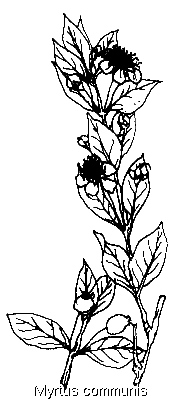MYRTLE
(Myrtus communis)

Appearance
This is a dense aromatic evergreen shrub between 1 and 3 metres
tall. The bark is reddish, and creamy white, sweet-scented flowers appear from
May to August. Edible blue-black berries develop in the summer.
Habitat
A member of the garigue or maquis growing along the edge of water
channels and on dunes by the sea with juniper from sea-level to 5,000 ft.
Grows all over Cyprus and is locally common on the Troodos and Kyrenia
ranges.
Uses and Properties
Strongly aromatic "Eau d'Anges", used in perfumery is
obtained from the flowers, leaves and bark, and indeed "myrtus" means
perfume in Greek. The berries have medicinal properties and were widely
used in ancient times to prevent hairloss, amongst other things, and myrtle
oil is still used as an antiseptic, nasal decongestant and against sinus
infections and colds. Fresh leaves or oil in bathwater are good for the
skin and relaxing. An acid drink is made from fermented myrtle berries.
The wood is durable, heavy and fine grained making it highly workable, it
also makes excellent charcoal.
According to Greek mythology, the nymph Daphne turned herself into myrtle
to avoid the attentions of Apollo. Myrtle was considered a symbol of love,
peace, a happy married life and was sacred to Aphrodite in ancient Greece.
Winners at the Olympic Games were crowned with wreaths of myrtle. Church
floors are still strewn with myrtle at Easter time. The Romans garlanded
poets and playwrights with myrtle.




